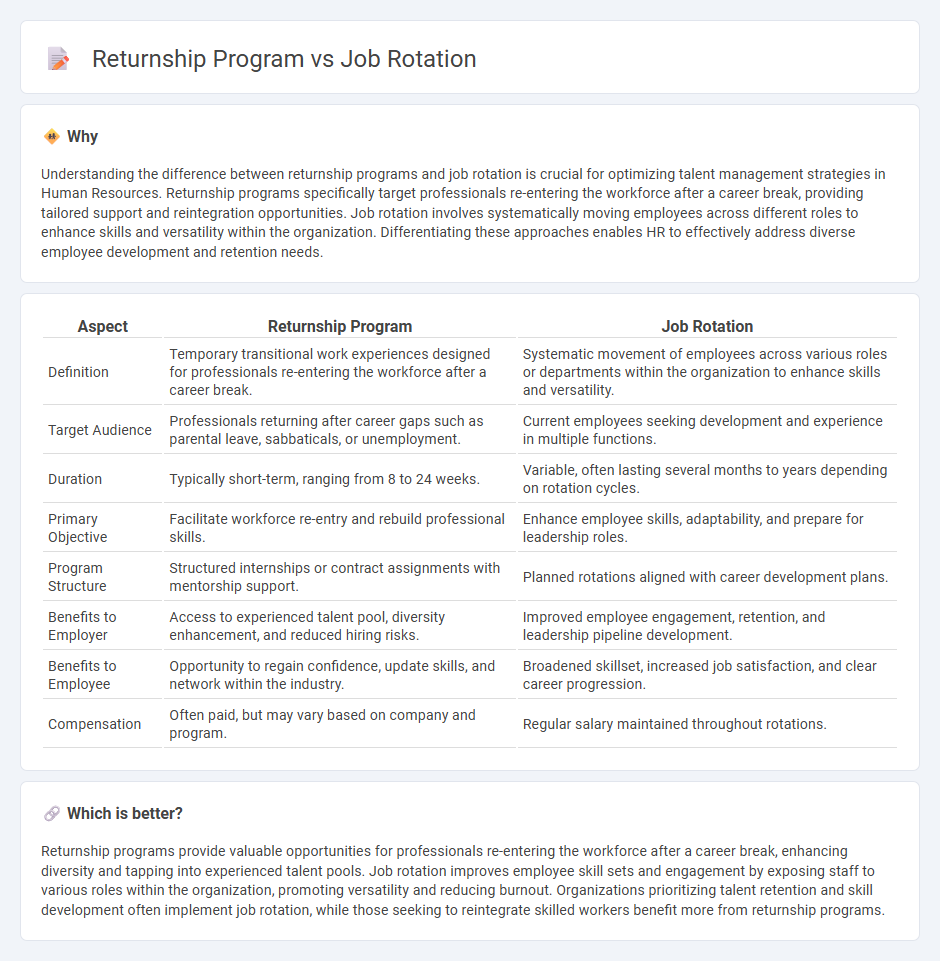
Returnship programs offer experienced professionals, especially those re-entering the workforce after a career break, structured opportunities to update skills and integrate into new roles. Job rotation involves systematically moving employees across different positions to enhance their skill sets, increase engagement, and improve organizational flexibility. Explore how these strategic HR initiatives can optimize talent development in your company.
Why it is important
Understanding the difference between returnship programs and job rotation is crucial for optimizing talent management strategies in Human Resources. Returnship programs specifically target professionals re-entering the workforce after a career break, providing tailored support and reintegration opportunities. Job rotation involves systematically moving employees across different roles to enhance skills and versatility within the organization. Differentiating these approaches enables HR to effectively address diverse employee development and retention needs.
Comparison Table
| Aspect | Returnship Program | Job Rotation |
|---|---|---|
| Definition | Temporary transitional work experiences designed for professionals re-entering the workforce after a career break. | Systematic movement of employees across various roles or departments within the organization to enhance skills and versatility. |
| Target Audience | Professionals returning after career gaps such as parental leave, sabbaticals, or unemployment. | Current employees seeking development and experience in multiple functions. |
| Duration | Typically short-term, ranging from 8 to 24 weeks. | Variable, often lasting several months to years depending on rotation cycles. |
| Primary Objective | Facilitate workforce re-entry and rebuild professional skills. | Enhance employee skills, adaptability, and prepare for leadership roles. |
| Program Structure | Structured internships or contract assignments with mentorship support. | Planned rotations aligned with career development plans. |
| Benefits to Employer | Access to experienced talent pool, diversity enhancement, and reduced hiring risks. | Improved employee engagement, retention, and leadership pipeline development. |
| Benefits to Employee | Opportunity to regain confidence, update skills, and network within the industry. | Broadened skillset, increased job satisfaction, and clear career progression. |
| Compensation | Often paid, but may vary based on company and program. | Regular salary maintained throughout rotations. |
Which is better?
Returnship programs provide valuable opportunities for professionals re-entering the workforce after a career break, enhancing diversity and tapping into experienced talent pools. Job rotation improves employee skill sets and engagement by exposing staff to various roles within the organization, promoting versatility and reducing burnout. Organizations prioritizing talent retention and skill development often implement job rotation, while those seeking to reintegrate skilled workers benefit more from returnship programs.
Connection
Returnship programs and job rotation are connected through their shared goal of enhancing workforce skills and career development. Returnship programs offer professionals re-entering the workforce structured, short-term roles, which often include rotational assignments across departments to build diverse competencies. Job rotation within these programs fosters adaptability and broadens experience, accelerating reintegration and employee engagement.
Key Terms
**Job Rotation:**
Job rotation enhances employee skills by systematically moving individuals across various roles within an organization, fostering versatility and reducing job monotony. This approach accelerates talent development, boosts employee engagement, and cultivates a deeper understanding of business operations. Explore how implementing job rotation can transform workforce capabilities and drive organizational success.
Cross-training
Job rotation enhances employee versatility by systematically moving staff through different roles to acquire diverse skills, which boosts cross-training effectiveness. Returnship programs specifically target experienced professionals re-entering the workforce, offering structured opportunities to update skills in varied functions, thereby facilitating smoother transitions. Discover how these programs optimize cross-training strategies to drive talent development and retention.
Skill diversification
Job rotation facilitates skill diversification by rotating employees through various roles, enabling hands-on experience across multiple functions and fostering adaptability. Returnship programs target skill redeployment for professionals re-entering the workforce, often emphasizing updated industry knowledge and practical training in a supportive environment. Explore more about how these programs enhance workforce capabilities and career growth opportunities.
Source and External Links
Job rotation - Wikipedia - Job rotation is the lateral transfer of employees between jobs within an organization at the same hierarchical level, used to improve employee motivation, manage fatigue, and aid career development without changing salary or rank.
Job rotation | EBSCO Research Starters - Job rotation is a human resources strategy that moves employees between various jobs to develop diverse skills, reduce burnout, increase job satisfaction, and enhance workforce flexibility.
Job Rotation : Meaning, Types, Methods, Advantages and ... - Job rotation involves shifting employees across positions or projects within a company to diversify skills, reduce burnout, and improve job satisfaction, using methods like time-based rotation, project-based rotation, and cross-training.
 dowidth.com
dowidth.com